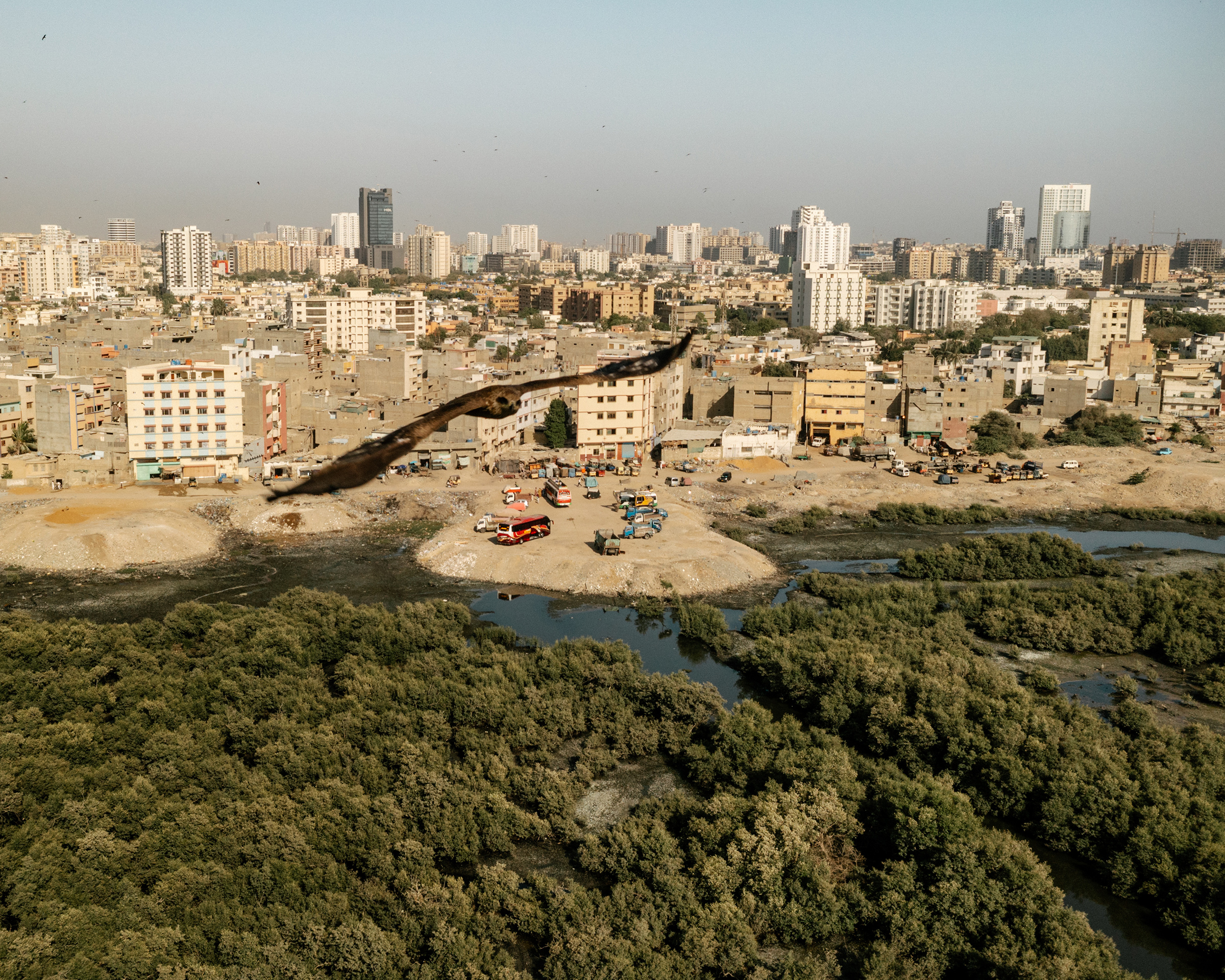On a recent Tuesday morning, several dozen Pakistani schoolchildren barreled down a wooden walkway into a thicket of mangroves. They jostled for space at a small viewing platform and eagerly pointed out fish darting between the exposed tree roots. As the rising tide inched ever closer to the crabs and mudskippers resting on shore, the children’s guide launched into a detailed explanation of the unique marine ecosystem fringing the coast, and how it provided both a vital nursery for ocean fish and protection from tsunamis and storm surges. If mangroves are so important, wondered one child out loud, “Why are they in here, and not out there?” By in here, she meant the soaring glass atrium of Karachi’s newly opened MagnifiScience Centre, where the high-tech centerpiece is the living mangrove exhibit—complete with real trees, live fish, plastic crabs, and an accelerated tidal ebb and flow maintained by underground water pumps. Out there is the crowded coastal megacity of Karachi, where all but a few of the mangrove forests that once defined this Indus Delta port town have been chopped down, paved over, and developed into ocean-view high-rises, golf courses, and container ports.
Mangrove forests are not just any old woodlands. They are one of the most powerful natural tools we have to simultaneously reduce climate-change risks and protect ourselves from the impacts that are already here—and those to come. This is especially true for warm coastal cities like Karachi.
In what’s left of Karachi’s original mangrove swamps, one of the museum exhibit’s designers is documenting, in forensic detail, the piecemeal destruction of a once pristine forest for his weekly social media dispatch. “There are days out here when you can’t hear a single bird because the chainsaws are so loud,” Tariq Qaiser murmurs into his iPhone with a David Attenborough cadence as he pans the camera over a clear-cut swath of stump-studded silt. Just a few weeks ago, he continues, “the tree canopy was overhead, and the light filtered through as if you were in a cathedral. Now …” He shakes his head mutely as he steers his small boat past a pile of cut branches destined for the city’s back-alley firewood markets and charcoal kilns.
Pakistan’s Indus River Delta is home to hundreds of thousands of acres of mangroves, and the country boasts one of the most successful mangrove reforestation projects in the world. But only a few remain in the economic capital of Karachi, where 16 million residents are corralled onto low-lying spits of land, many of which have been reclaimed from the sea. Qaiser, an architect of some renown, with thick gray hair, horn-rimmed glasses, and a late-middle-age paunch he attributes to COVID-enforced inactivity, has spent the past half decade fighting for the protection and expansion of a small patch of mangroves rooted at the tip of a tidal island directly facing some of Karachi’s most valuable land.

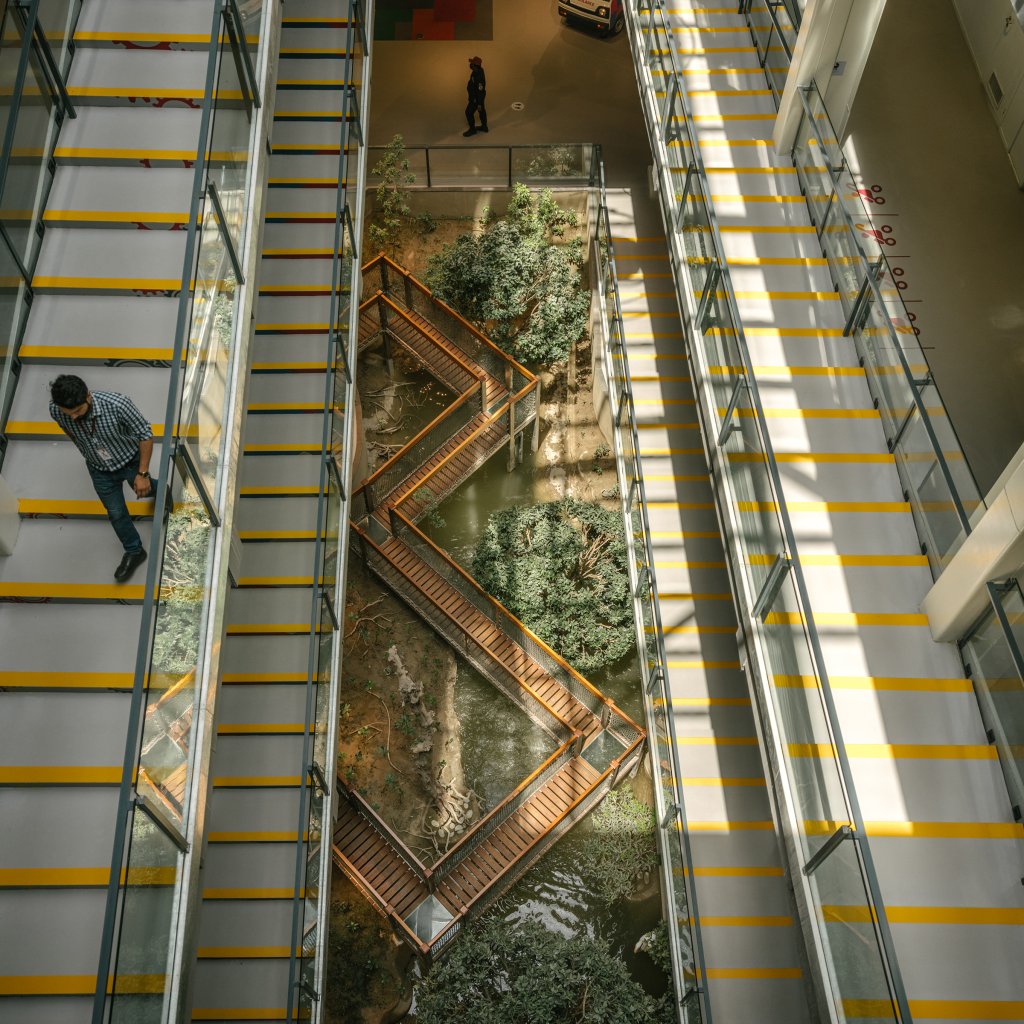
Developers envision landfilling Bundal Island, linking it to the mainland via a causeway, and turning it into prime real estate for an ever expanding city. Qaiser sees the island as the terrestrial incarnation of Abdullah Shah Ghazi, the patron Sufi saint of Karachi, who protects the city from storms, disease, and hunger. “I don’t want to fight with the developers,” Qaiser says. “But I do want them to think about the future of this city.” In a congested metropolis already plagued by the urban heat-island effect, in which endless expanses of concrete buildings and paved roads amplify the already sweltering temperatures by several degrees, trees are a threatened resource. Mangroves, says Qaiser, “are our air-conditioning, our oxygen supply. If you just increase the mangrove cover, Karachi’s next 30 years will be much better than if you build over them.”
The world will be better as well. By sequestering carbon, mangroves help slow climate change. They also protect locals against some of its effects, like rising sea levels and increasingly severe storms. Qaiser’s quest to save Karachi’s last intact mangrove forest comes against the backdrop of a growing global movement to preserve those that remain and replace what has been lost. In this battle, his weapon of choice is a series of short, stunning nature videos filmed in and around Karachi’s mangroves. He disseminates them weekly via Whats-App to some 2,000 contacts, and urges his followers to share widely. And they do. At 197 and counting, his 90-second dispatches (the maximum allowed by WhatsApp) have raised awareness among the urban elite, and have in some instances spurred officials to act, sending in security to stop illegal woodcutters. But in a city where land is at a premium, development is the bigger threat. Keeping Bundal Island intact means educating a new generation of Karachiites about the value of not just the mangroves but the entire surrounding ecosystem. That was the impetus behind the museum’s mangrove exhibit, says Qaiser. The problem is that by the time the schoolkids are in a position to make any decisions, it might be too late—not for Pakistan’s mangroves, which are flourishing, but for Karachi’s, which are not.
Stretched over approximately 600 acres, Bundal Island’s mangroves account for less than 0.2% of Pakistan’s coastal forest cover. They are largely inaccessible, visited primarily by private boat owners like Qaiser, illegal woodcutters, and camel herders who swim their animals over to graze at low tide. From Karachi, the dense thicket appears as a faint green line on the horizon, perpetually smudged by haze and smog. Given the immensity of Pakistan’s problems—political instability, economic crisis, the perpetual threat of terrorism, and the deleterious impact of climate change—saving this tiny sliver of an island may seem a quixotic exercise, tilting at construction cranes when far more dangerous threats loom.
Yet Qaiser girds for battle as if the very future of his city were at stake. In a way it is.
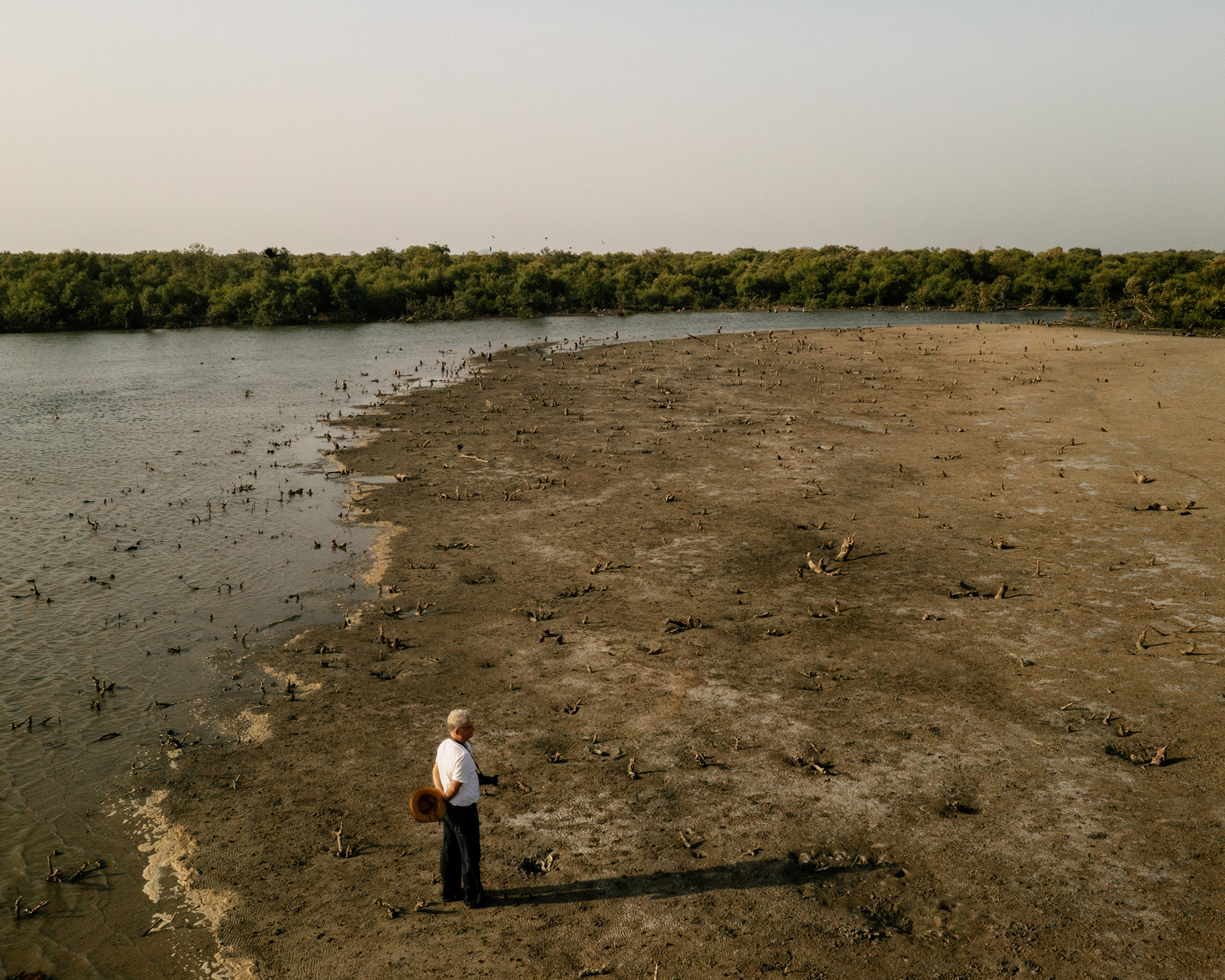
Often dismissed as mosquito-ridden, unproductive swamps, mangroves are in fact bio-diverse ecosystems whose protection delivers more carbon-sequestration bang per buck than almost any other intervention. Though they occupy only 0.5% of the earth’s shorelines, they account for up to 15% of coastal carbon-storage capacity, holding the equivalent of more than 21 gigatons of CO2, roughly as much as China currently emits over two years. The salt-tolerant trees are adept at filtering pollutants from seawater, and their extensive root systems are important nurseries for fish, home to a wide variety of crustaceans, and the feeding grounds for migrating birds, crocodiles, and even big cats—mangrove aficionados claim that Rudyard Kipling’s fictional The Jungle Book, with panther Bagheera and tiger Shere Khan, must have been set in the Bay of Bengal’s Sundarbans, the largest contiguous mangrove forest in the world.
Those roots also trap sediment, preventing erosion and protecting coastal communities, especially during storms. When a massive tsunami swept through the Indian Ocean in 2004, killing at least 225,000 and leveling towns from India to Indonesia, areas still fronted by mangrove forests were largely spared. As sea levels rise because of global warming, mangroves will play an even more important role in protecting coastal cities like Karachi from flooding. The United Nations environment program estimates that between fisheries, tourism, and coastal protection, mangroves provide ecosystem services to humanity worth $462 billion to $798 billion per year.
The problem is that mangroves grow in tropical regions where river deltas meet the sea—often the type of oceanfront property prized by developers, the agriculture industry, and shrimp farmers. As a result, more than a third of the world’s mangroves have been chopped down for firewood and construction materials, cleared to make space for development or aquaculture, or poisoned by pollution resulting from nearby industrial growth.

But these days, mangroves are having a bit of a moment. Their astonishing carbon-sequestration capabilities—acre for acre, they store up to four times as much as terrestrial forests do—has spurred interest from carbon-capture investors. When British marine scientist Steve Crooks started developing mangrove restoration projects a decade ago, he struggled to find funding. Now he regularly gets calls from investors seeking to put $100 million into carbon-capture projects—with some such proposals edging into the billion-dollar range. So-called blue-carbon projects that tap the sequestration potential of the world’s oceanic and coastal ecosystems are in high demand, says Crooks. The fact that mangroves provide other climate-related benefits makes them even more attractive. Private investors as well as major global corporations such as Microsoft and Amazon, he says, “are all realizing that they need carbon credits, but they don’t just want any carbon credits. They want carbon credits that are socially and environmentally impactful.” Mangroves are the perfect one-two punch investment, says Crooks: sequestering carbon while protecting communities, and providing food and livelihoods. “It comes with a bright shiny halo.”
As a result, mangrove restoration is on the rise. Over the past 20 years, mangroves have gone from being one of the fastest diminishing habitats on earth to being one of the best protected, with 42% of all remaining mangrove areas under some kind protective status, according to the Global Mangrove Alliance. The rate of mangrove loss, once more than 3% a decade, is now down to less than 1%—and in some places, like Bangladesh and Pakistan, coverage is actually increasing. While restoring mangroves to their full 1980 extent—when global measurements were first taken—is difficult because of the irreversible growth of cities like Karachi, returning coverage to 1996 levels is “probably likely,” says Catherine E. Lovelock, a professor of biological sciences at the University of Queensland, Australia, and one of the world’s foremost experts on mangrove restoration.
Over the past few years, many ambitious mangrove restoration programs have been launched around the world, but have frequently ended in failure. In some cases, that’s been because the seedlings were planted in places that didn’t support the unique needs of the trees—mangroves may tolerate salt water, but they still require a source of fresh water to thrive. In others, it was because the planting projects didn’t get adequate buy-in from local communities. For example, in the wake of the devastating 2004 Indian Ocean earthquake and tsunami, the Sri Lankan government embarked on a $13 million donor-funded mangrove-restoration project, complete with national planting parties and widespread media coverage. But the projects didn’t include adequate planning, long-term monitoring, or post-planting care, so the nascent forests were not protected from wood harvesters and herders. The average failure rate of those projects was 80%, according to a 2017 study published in Restoration Ecology.
Pakistan is one of the rare exceptions, says Lovelock. It has seen a trebling of mangrove coverage over the past three decades, from 477 sq km (184 sq. mi.) in 1990 to approximately 1,464 sq km (565 sq. mi.) in 2020. The success is a testament to the fact that Pakistan has both the land and the community support necessary for such large-scale success, says Rafiul Haq, an ecologist and member of the International Union for Conservation of Nature Commission (IUCN) on Ecosystem Management for Pakistan.
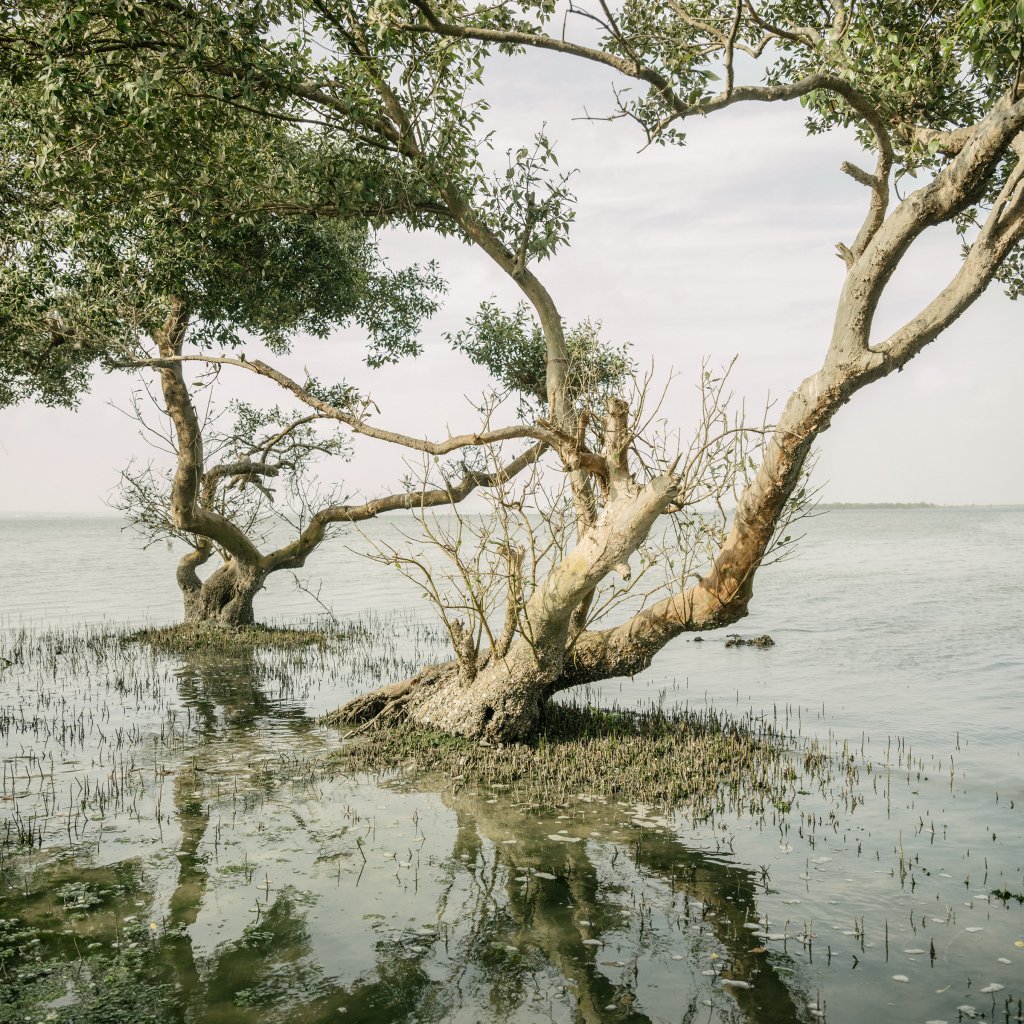

The country also has—at least until recently—strong government commitment. In 2015, former cricket legend and politician Imran Khan launched a campaign to plant 1 billion trees in an effort to combat the consequences of climate change in the mountainous province of Khyber Pakhtunkhwa, where his party was then in power. His effort was so successful—the province says it reached that goal in two years—that when he became Prime Minister in 2018 he took the program national, announcing a “10 billion-tree tsunami” in 2019. Of the 3.2 billion trees set to be planted by 2023, nearly a third were to be mangroves, says Malik Amin Aslam, Khan’s Federal Minister for Climate Change. Khan was ousted in April, but his outsize plan has already taken root, says Aslam: mangrove coverage increased by 214.93 sq km (82.98 sq. mi.) from 2015 to 2020. Aslam says that continuing the mangrove expansion is vital: “This is in the interest of Pakistan, not of any one political party.” But it’s not clear if the progress will continue; the incoming federal government has said that tree planting is no longer its “core policy on global warming.”
Nevertheless, a provincial-level planting program, conducted in tandem with private venture-capital group Indus Delta Capital, plans to protect and reforest about 865,000 acres of tidal wetlands to the southeast of Karachi as part of a blue-carbon credit initiative. Nearly 100 million trees have already been planted, says Crooks, the marine scientist who helped design the project, which was launched in 2015. Once completed, the VC group says that Delta Blue Carbon project will be one of the biggest mangrove-restoration programs in the world, able to sequester nearly 150 million tons of carbon over a 60-year period.
Most of the world’s mangrove-restoration projects are much smaller, both in acreage and carbon-sequestration potential. Few countries have Pakistan’s wide expanses of largely uninhabited and suitable delta terrain. But hundreds of small projects are flourishing around the world, from Kenya—where 3,000 residents of the coastal town of Gasi Bay have given up mangrove logging in favor of planting jobs paid for by carbon credits—to India’s Karnataka state—where locals are leading a new conservation program in a mangrove forest spanning 300 hectares—to southern Thailand—where villagers are promoting natural mangrove regeneration in abandoned shrimp farms.

Mangroves located around cities are much harder to restore than those in more rural areas, says Lovelock. Population density, property prices, and competing land-use demands limit potential. Still, there are successes: Miami and Brisbane have both implemented robust restoration programs, and Singapore defends its “tiny little patches like crazy against the developers,” she says. “And you can imagine how much a meter of land in Singapore costs.”
Karachi’s mangroves don’t get that kind of support. For all the successes elsewhere in the Indus Delta, the provincial capital is a glaring exception. Decades of development, illegal logging, badly managed irrigation projects, and the steady stream of untreated sewage and industrial pollutants have taken a toll, leaving the metro region’s once luxuriant forests in a precarious state. The western bank of the Indus, where Karachi is located, is the only part of Pakistan that has seen a decline in mangrove coverage over the past decade. But as sea levels rise because of climate change, Karachi needs the natural defense of the mangroves more than ever. The city is already prone to flooding; in the summer of 2020, record rainfall inundated downtown buildings and rose chest-deep in the streets. Aslam, the Climate-Change Minister under Imran Khan, blames the flooding on the city’s voracious real estate developers and acquiescent officials who look the other way when mangroves are ripped out to make way for seaside high-rises. In turning a quick buck, he says, they are undermining the city’s future. By law, all of Pakistan’s mangroves are protected, but enforcement is weak. “The land mafia”—Aslam’s term for corrupt developers—“are selling a view, but their foundations are on fragile ground. Mangroves are the only defense system the city has against storm surges. Sooner or later, the city will realize that nature always wins.”
The few remaining mangroves near the city center are putrid sinks of raw sewage littered with the detritus of residents who see them as little more than a convenient garbage dump. On the city’s offshore islands, it’s a different world. The air is fresh and oxygenated, sweetened by the perfume of mangroves in bloom. Herons and migrating flamingos stalk the shallows, while fish eagles nest in high branches. Shoals of fish leap from the still waters, pursued by unseen predators below. The Karachi skyline looms large on the horizon, but the urban clamor is silenced, replaced by birdsong and the steady snap, crackle, and pop of settling mud. “These mangroves are magic,” says Qaiser. “According to everything we know about trees, they should not be here.” They thrive despite the constant exposure to the city’s untreated sewage and industrial pollutants, turning human waste into green gold, he says. “We have to do everything possible to protect them.”
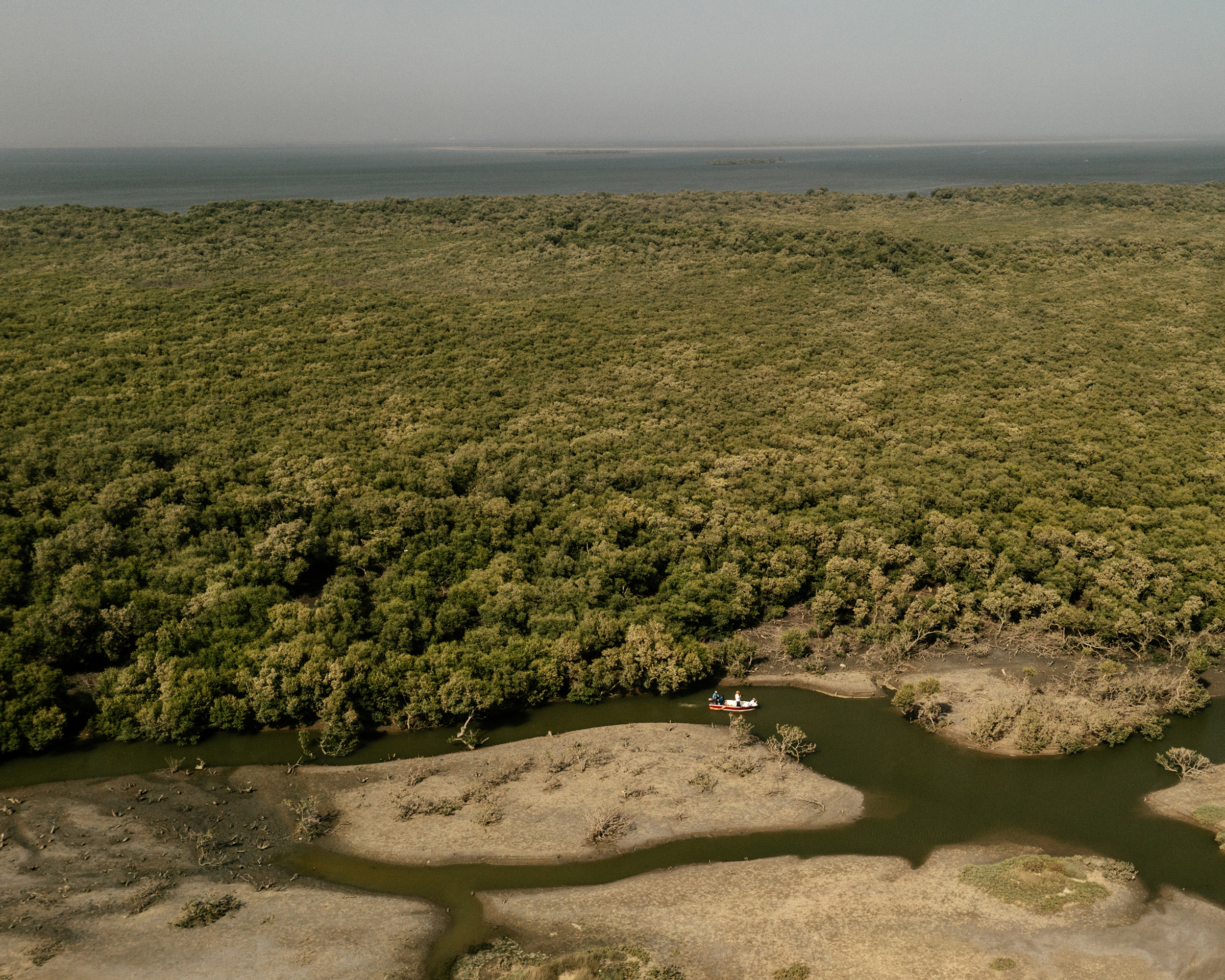
Qaiser discovered the Bundal Island mangroves almost by accident. Professionally, he’s an architect, with a specialty in hospitals and schools. But he’s also an amateur photographer and sport fisher, and he used to pass the mangroves on his boat trips into deeper waters. In 2012 he noticed one tree in particular, a majestic Avicennia marina, known commonly as the white or gray mangrove, whose crown spanned several dozen feet. It became his muse, and he returned every few weeks to photograph it as the tides, the seasons, and then the years, turned. In January 2016, he found it cut down to a stump, traces of sawdust still floating on the rising tide.
“I didn’t go back for six months,” he says. “I was in mourning.” When he finally returned to Bundal Island, it was with a mission: “There was a need for action. It was a calling.” He and a fellow photographer started systematically documenting the illegal harvesting, going out to the island mangroves several times a week to note new cuts, and learning the marks that loggers would leave to indicate which trees would be next. Qaiser became friends with the camel herders who use the mangroves for animal forage and got to know the local fishermen. He even visited the Karachi lumberyards and charcoal kilns that buy illegally harvested wood for 40 rupees (about $0.50) a kilogram, learning to his chagrin that his beloved tree probably fetched little more than the equivalent of $800 in total—“not even worth the manpower and the petrol.” But he never directly confronted the “timber mafia,” as he calls them. In Pakistan, environmental activists have been killed for less—for example, social-rights activist Parveen Rahman was murdered in 2013 for her work, it is believed, documenting the predations of both Karachi’s land and timber mafias. Given the risks, Qaiser instead used his findings to launch an education program, and then his video campaign on social media.
His efforts have paid off, sort of.
In February, the High Court of Sindh province, where Karachi is located, declared the Bundal Island mangroves to be protected forests, citing their role in coastal protection, biodiversity preservation, and carbon-capture potential. But the unforested part of the island remains unprotected. In 2020, Imran Khan’s government announced a $50 billion development project on Bundal Island that would “surpass Dubai,” the idea being that building infrastructure there would ease the congested city’s housing crunch while bringing in much-needed revenue. It’s the fourth such project to have been put forward since 2000, and none has come to fruition, largely because of debates over ownership rights between the federal and provincial governments. Nonetheless, development of the islands seems inevitable, says Aslam resignedly. “They are small specks, and they have got real property value.” His fellow Cabinet members in the Khan Administration have argued that development would bring in billions, and that the revenue could be used to plant more mangroves elsewhere. As an environmentalist, Aslam would like to see the islands preserved, but as a politician, he can understand the argument for development.
Developing the islands would spell the death of their mangroves, argues Qaiser. Because much of Bundal Island floods at high tide, construction would also involve environmentally damaging reclamation work on the surrounding sandbanks. That risks upsetting the tidal exchange of fresh water and salt water that keeps the trees healthy. “This is a really resilient plant—it will grow in raw sewage for half a decade—but you have to be very careful that you don’t disturb the ecology,” he says. Further, Qaiser believes the development plan doesn’t adequately account for the missed climate-adaptation opportunities. He has mapped out Bundal Island using his architecture firm’s AutoCAD software and has found that currently the forest occupies 10% of the island’s 24 sq km (9.2 sq. mi.). He estimates that given the flooding patterns, an additional 40% of that land could be replanted. “In terms of carbon sequestration, that’s mind-bogglingly huge. For a city like Karachi, it’s a godsend, a real gift.”
The only way to make it happen, says Qaiser, is to turn all of Bundal Island into a protected marine reserve. “I want the impossible,” he acknowledges. “Karachi is in crisis. We need a biodiverse wilderness if we are going to survive into the next few decades. This isn’t about saving the mangroves; this is about saving Karachi.”
Haq, the IUCN consultant who also worked with Qaiser on the museum exhibit, appreciates his “extraordinary work” educating the public, and his ambition. But Haq worries that Bundal Island is a lost cause, and wishes Qaiser would look at the bigger picture and focus more on successes elsewhere in the country. Karachi constitutes only 7% of Pakistan’s mangroves, Haq points out. “It’s not justifiable to focus on the losses in 7% while ignoring the success in 93%.” Lovelock, the mangrove expert, says there is worth in both large restoration projects and small preservation efforts, which are typically more accessible to the general public, and so make for excellent venues for education and recreation. “We need these small slivers so we can learn to appreciate the big ones.”
Qaiser thinks it’s essential to protect every bit there is. “When you say, ‘Why bother with the 7%?’ you are reciting a death sentence for the rest,” he says. Karachi’s appetite for growth is insatiable, he points out. “If you make it acceptable to destroy the forest right in front of the city, what happens when the city expands? It’ll become acceptable to use those islands too. Where does it stop? When the only mangroves left are the ones in the museum?”
Read More from The Oceans Issue
The Story Behind TIME’s Oceans Issue Cover
The Ocean Is Climate Change’s First Victim and Last Resort
We’re Gonna Need a Greener Boat
The Motion of the Ocean Could Be the Next Big Source of Green Energy
More Must-Reads From TIME
- The 100 Most Influential People of 2024
- Coco Gauff Is Playing for Herself Now
- Scenes From Pro-Palestinian Encampments Across U.S. Universities
- 6 Compliments That Land Every Time
- If You're Dating Right Now , You're Brave: Column
- The AI That Could Heal a Divided Internet
- Fallout Is a Brilliant Model for the Future of Video Game Adaptations
- Want Weekly Recs on What to Watch, Read, and More? Sign Up for Worth Your Time
Contact us at letters@time.com
